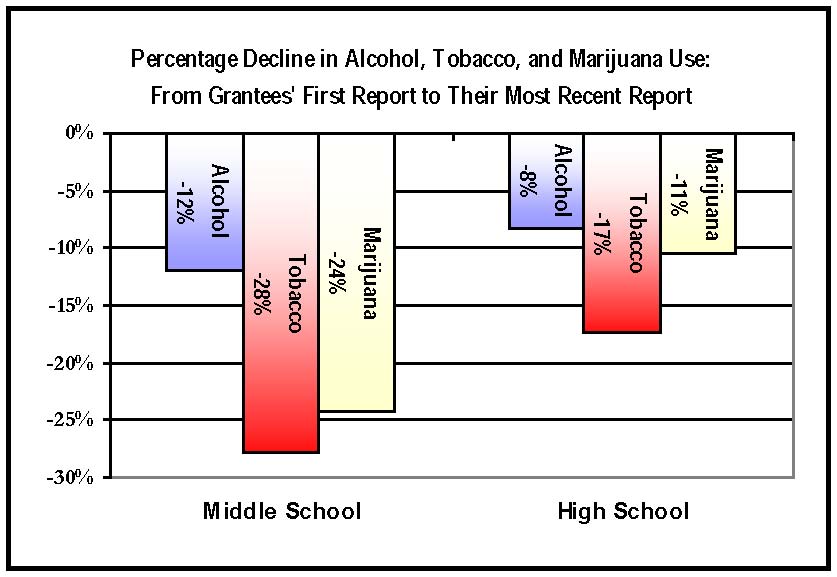Sample Uses of the National Evaluation Data
Attachment 9_Sample Use of National Evaluation Data.doc
Drug Free Communities Support Program National Evaluation
Sample Uses of the National Evaluation Data
OMB: 3201-0012
Attachment 9:
Sample Uses of the National Evaluation Data
The
goals of the Drug Free Communities Support Program (DFC) are to
strengthen community collaboration and to reduce youth substance
use.
Administered
by the Office of National Drug Control Policy (ONDCP), in
partnership with the Substance Abuse and Mental Health Services
Administration (SAMHSA), the DFC grant program supports community
coalitions in preventing and reducing youth substance use. The
contributions of community coalitions constitute a critical part of
the Nation’s drug prevention infrastructure. They are, in
fact, a significant catalyst for creating local change where drug
problems manifest and affect the citizens of this country. DFC
grantees are required to provide data for the national evaluation of
DFC, and a summary of findings from these grantee-reported data
follows.
What
Have We Found So Far?
• Rates
of Substance Use Have Declined
Significantly
in DFC Communities: Past
30-day
use
declined significantly across all substances
(alcohol,
tobacco, marijuana) and all grade levels
(middle
school, high school) between DFC
coalitions’
first and their most recent data report.
Moreover,
prevalence of 30-day use was lower
across
all substances for DFC high school
students
than among a nationally-representative
sample
of high school students taking the Youth
Risk
Behavior Survey (YRBS). Differences in
prevalence
of 30-day use between DFC and YRBS
2005,
2007, and 2009. Differences in prevalence
of
30-day use were also statistically significant for
marijuana
in 2003, 2005, and 2007, but not in
2009.
• Perceptions
of Substance Use are Moving Significantly in the Right Direction:
Perception of risk increased
significantly
for alcohol, tobacco and marijuana use among DFC youth between DFC
coalitions’ first report and most
recent
report. Moreover, youth perception of parental disapproval increased
significantly for alcohol, tobacco and
marijuana
use over the same period.


Recent
Trends
The
following trends were observed among grantees that reported outcome
data in 2009. Because DFC grantees are required to report outcome
data every two years, these recent trends are based on data from
roughly half of DFC grantees.
• High
School Tobacco Use Continues to Decline Significantly in DFC Grantee
Communities:
Between DFC grantees’ 2009 data report and their previous
report (typically from 2007), high school tobacco use declined
significantly (-1.8 percentage points). Changes in 30-day use of
alcohol and marijuana were not statistically significant over the
same period.
• Perceptions
of Risk of Marijuana Use Are Declining:
In 2009, DFC grantees reported a statistically significant decline
in the perception of risk of marijuana use in both middle school
(-2.3 percentage points) and high school (-4.8 percentage points).
Although 30-day use of marijuana at the middle school and high
school level did not change significantly in 2009, it is nonetheless
important to carefully monitor this trend since declines in
perception of risk have been shown to predict increases in substance
use.
were
statistically significant for alcohol in 2003,
As
with any evaluation, the DFC evaluation has a number of limitations
that may affect the results. Because of these limitations and the
uncertainty they produce, we cannot claim a causal relationship
between DFC coalition activities and the outcomes reported here.
However, the results are consistent with our expectation that DFC is
effective when the program has been implemented as intended.
Summary
of Findings from January 2002 through November 2009
National
Evaluation of the Drug Free Communities Support Program
| File Type | text/rtf |
| Author | ICF |
| Last Modified By | 15150 |
| File Modified | 2011-08-05 |
| File Created | 2011-04-04 |
© 2025 OMB.report | Privacy Policy